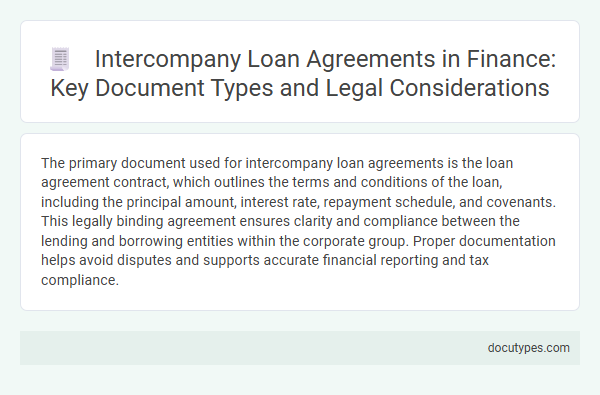The primary document used for intercompany loan agreements is the loan agreement contract, which outlines the terms and conditions of the loan, including the principal amount, interest rate, repayment schedule, and covenants. This legally binding agreement ensures clarity and compliance between the lending and borrowing entities within the corporate group. Proper documentation helps avoid disputes and supports accurate financial reporting and tax compliance.
Introduction to Intercompany Loan Agreements
Intercompany loan agreements are formal contracts used to document loans made between affiliated companies within the same corporate group. These agreements establish the terms and conditions of the loan, including interest rates, repayment schedules, and covenants. Proper documentation ensures compliance with tax regulations and financial reporting standards for intercompany transactions.
Importance of Intercompany Loans in Corporate Finance
Intercompany loan agreements are typically documented using a formal Loan Agreement or Agreement for Intercompany Financing. This document outlines the terms, interest rates, repayment schedules, and other critical conditions related to the loan between affiliated entities.
Intercompany loans play a vital role in corporate finance by facilitating liquidity management and optimizing capital allocation across subsidiaries. These loans help improve cash flow efficiency, reduce external borrowing costs, and support strategic business operations within a corporate group.
Key Document Types for Intercompany Loan Agreements
| Document Type | Description | Purpose in Intercompany Loan Agreements |
|---|---|---|
| Intercompany Loan Agreement | A formal contract outlining the terms and conditions of the loan between affiliated entities within a corporate group. | Defines loan amount, interest rate, repayment schedule, and obligations of borrower and lender to ensure compliance and clarity. |
| Promissory Note | A written promise by the borrowing entity to repay the loan under specified terms. | Serves as proof of debt and commitment to repay, reinforcing the legal enforceability of the loan. |
| Board Resolutions | Official approvals by the governing body of lending and borrowing entities authorizing the loan agreement. | Provide internal authorization and demonstrate adherence to corporate governance requirements. |
| Transfer Pricing Documentation | Reports and analyses supporting the arm's length nature of the loan terms based on comparable market transactions. | Ensures compliance with tax regulations by validating that interest rates and loan conditions are fair and reflect market standards. |
| Security Agreement (if applicable) | Document granting collateral rights to the lender over certain assets. | Protects Your interests by securing repayment through pledged assets, reducing credit risk in the intercompany loan. |
Essential Clauses in Intercompany Loan Documents
Intercompany loan agreements are formal documents that outline the terms and conditions of loans between subsidiaries within the same corporate group. These documents ensure clear financial arrangements and compliance with regulatory standards.
Essential clauses in intercompany loan documents include the principal amount, interest rate, and repayment schedule. The agreement must specify the governing law and dispute resolution mechanisms to manage potential conflicts. Covenants related to the use of funds and financial reporting requirements are crucial for transparency and control.
Legal and Regulatory Framework for Intercompany Loans
Intercompany loan agreements are formalized using a loan agreement document that outlines the terms, interest rates, repayment schedules, and obligations between related entities. This document ensures clarity and legal enforceability of the loan within corporate groups.
The legal and regulatory framework governing intercompany loans includes adherence to transfer pricing rules, tax regulations, and corporate laws in relevant jurisdictions. Your agreements must comply with arm's length principles to avoid tax penalties and ensure regulatory approval.
Transfer Pricing and Tax Implications
Intercompany loan agreements require a formal document to ensure compliance with transfer pricing regulations and minimize tax risks. Proper documentation is essential for substantiating arm's length terms and protecting Your company during tax audits.
- Intercompany Loan Agreement Document - This legal contract outlines the terms, interest rates, repayment schedules, and covenants between related entities.
- Transfer Pricing Documentation - Supporting schedules and analyses demonstrate that the loan's terms meet arm's length standards set by tax authorities.
- Tax Compliance Records - Detailed records of interest payments and related party transactions assist in reporting and avoiding transfer pricing adjustments or penalties.
Risk Management in Intercompany Lending
Which document is essential for formalizing intercompany loan agreements? The Intercompany Loan Agreement serves as the primary document that outlines the terms, conditions, and obligations between related entities. This agreement is critical for managing risks such as default, transfer pricing issues, and regulatory compliance in intercompany lending.
Documentation Best Practices for Compliance
Intercompany loan agreements require precise documentation to ensure regulatory compliance and clear financial obligations between entities. Proper documentation mitigates legal risks and supports transparent internal audits.
- Loan Agreement Document - Serves as the primary legal contract outlining terms, interest rates, repayment schedules, and conditions.
- Board Resolutions - Official approvals from each company's board validating the loan's authorization and compliance with corporate governance.
- Transfer Pricing Documentation - Demonstrates arm's-length terms to meet tax regulations and avoid profit shifting concerns.
Maintaining comprehensive records aligned with regulatory standards establishes trust and safeguards financial integrity in intercompany transactions.
Common Disputes and Resolution Strategies
Intercompany loan agreements are typically documented using a formal Loan Agreement that outlines terms, interest rates, repayment schedules, and covenants. Common disputes arise from unclear terms, delayed repayments, and disagreements over interest calculations. You can resolve these issues through thorough contract drafting, mediation clauses, and regular financial reconciliations to ensure transparency and adherence to agreed terms.
Which Document Is Used for Intercompany Loan Agreements? Infographic

